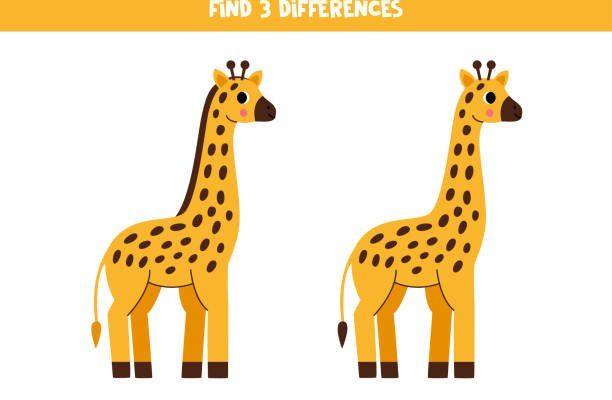![Comparing The Giraffe Vs. [Similar Species]](https://gudri.com/wp-content/uploads/2025/06/Comparing_The_Giraffe_Vs___Similar_Species__image_0.jpg)
At a glance, the differences between giraffes and okapis might seem subtle, but they tell a fascinating story about how species adapt to their environments. Join me on this journey as we explore their characteristics, habitats, and more. Spoiler alert: you might just find yourself rooting for one over the other!
Physical Appearance
When you look at a giraffe, it’s hard to miss that *towering height*. Adult giraffes can reach up to 18 feet, with their necks accounting for about six feet of that! They have distinctive spotted coats, which help camouflage them among the trees and are unique to each individual, kind of like your fingerprints. Their long legs make for graceful strides, but they can also run surprisingly fast—up to 37 miles per hour!
Now, let’s shift gears and talk about the okapi. Although they’re not nearly as tall, okapis have their own unique charm. With their deep brown coats, striking white stripes on their legs, and large ears, they resemble a living piece of art. They typically stand about 4.5 to 5.5 feet tall at the shoulder. While they lack the giraffe’s towering neck, they do have a long, flexible tongue that helps them grasp leaves—a clever adaptation for their forest home.
Adaptations for Survival
Giraffes have developed long necks primarily for feeding. By reaching high into the treetops, they can access food that other herbivores can’t. This gives them a competitive advantage, especially during dry seasons when food is scarce. Their long necks also help them spot predators from afar.
In contrast, okapis have adapted to thriving in dense, tropical forests. Their striped legs break up their outline, helping them blend into the dappled sunlight filtering through the trees. This camouflage is crucial because their main predator, the leopard, relies heavily on stealth. Okapis are also known to be more solitary than giraffes, which helps them avoid detection.
Habitat and Distribution
Giraffes are the true icons of the African savanna. You’ll find them roaming the open plains of countries like Kenya and Tanzania. They prefer areas with plenty of acacia trees, their favorite snack! Giraffes are social creatures and often live in loose herds, which helps provide safety in numbers. Being able to keep an eye on one another is vital when you’re munching on lunch in an area populated by lions.
Okapis, on the other hand, are masters of the rainforest. Native to the dense forests of the Democratic Republic of the Congo, they thrive in environments that are rich in foliage but low in visibility. Because of habitat loss and poaching, okapis are considered endangered. Their secretive nature and preference for shaded areas make them more difficult to spot in the wild, contributing to their rarity.
Diet and Feeding Habits
Giraffes are browsers, which means they primarily eat leaves, fruits, and flowers, mainly from tall trees. Their long necks and prehensile tongues allow them to strip leaves from branches with remarkable ease. In fact, they spend a lot of their day—up to 20 hours!—eating. This constant grazing is necessary to support their massive size.
On the flip side, okapis are also herbivores but have a more varied diet. They eat leaves, fruits, and even some grasses. Their adaptable feeding habits allow them to survive in their dense woodland home, munching on whatever is available. Interestingly, okapis can also eat clay, which provides essential minerals that help them thrive.
Behavior and Social Structure
Giraffes are quite social, often forming groups that can change throughout the day. These herds are a mix of males and females, with females typically staying with the group longer. They communicate through body language and a range of sounds, including low-frequency rumbles that travel long distances.
Okapis, however, are more solitary and shy. They usually prefer to be alone or in small family groups, which includes a mother and her calf. Their elusive behavior is designed to keep them safe from predators. When they do meet other okapis, they engage in gentle social interactions, like grooming each other. This bonding helps strengthen social ties and maintain peace in their hidden world.
Conservation Status
While both giraffes and okapis face challenges, their conservation statuses differ significantly. Giraffes have recently been listed as vulnerable due to habitat loss and poaching, with some populations declining sharply. Conservation efforts are underway to protect these majestic creatures—think anti-poaching initiatives and habitat restoration projects.
Okapis, unfortunately, are in a more precarious position. Classified as endangered, their numbers are dwindling due to deforestation and hunting. Protected areas are crucial for their survival, but these measures must also combat illegal poaching to ensure future generations can enjoy these unique animals.
As we wrap up this comparison of the giraffe and the okapi, it’s clear that both species are remarkable in their own right. Giraffes represent the beauty of adaptability in open landscapes, while okapis showcase the wonder of life in dense forests.
So, if you ever find yourself in the savanna or wandering through a rainforest, take a moment to appreciate these incredible animals. Whether you’re cheering for the towering giraffe or the elusive okapi, remember that nature’s creativity knows no bounds. Both animals remind us of the rich tapestry of life on our planet, urging us to protect and cherish it for years to come.

